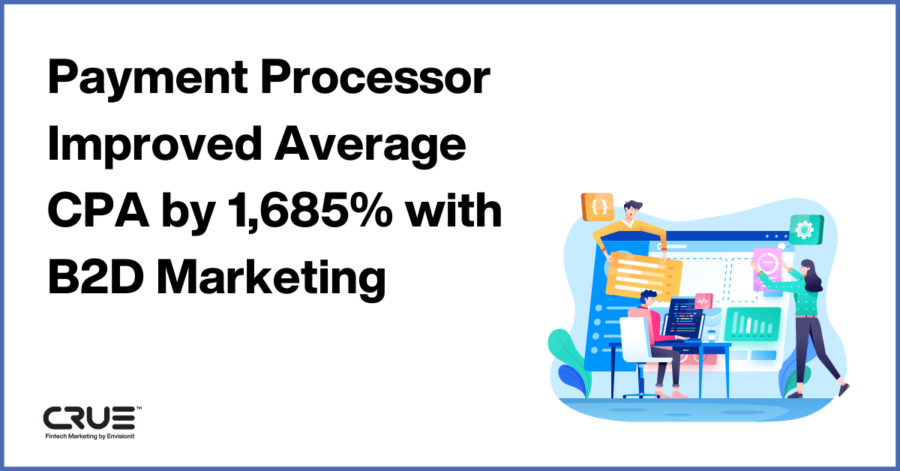Noise, buzz and endless disruption. These are the sounds of fintechs continually jockeying for position in a channel that’s moving further into the mainstream. There typically isn’t a breakthrough, watershed moment—success comes from a sustained, incrementally improving program that involves straightforward, but coordinated, strategies. Looking to get to that next milestone? Here are some essential marketing elements to consider:
Language is important: Use your outside voice
Many fintech companies are developing entirely new categories of products and services. It’s challenging to figure out how people are thinking about them and searching for them when there’s no shared vocabulary. It’s important to gather all the search data you can before you start your campaign so you can be sure you’re using the right language. Many companies fall into the trap of extending internal language (that isn’t understood the same way externally) to talk about and classify their solutions. And with this research you’ll also likely find new angles to pursue. Keep testing these terms and the engagements they create.
Feel their pain (Social listening)
It could be a little thing, but if it’s a little nagging thing people have to deal with every day, it can become a big thing. And if you can solve this problem then you’ve aligned the universe in their favor. Pay attention to aspects of your competitor’s products that are generating complaints or maybe there are products that people bemoan the loss of on social channels like Twitter. Get the advantage by addressing these needs and challenges head on. Social listening can turn up a lot of fertile ground.
Share the vision: Qualify leads and send the right messages
How does a prospective customer behave early in the path to purchase? What about later? Map out these points and document them so you can nudge them along in a coordinated fashion (sales and marketing teams unite!). If your sales team says they don’t need data or they use their “gut”, tell them gut instincts are developed over time with data then wink. And make sure your agency stays tethered to what a high-value lead looks like. A scorecard that explains how leads are qualified and scored should be universally recognized, and everyone should have the insights and they should be formatted in a way that’s easy to use (curb your data dumpers).
Make it personal
Creating great, painless experiences for users should be a guiding mantra for all industries, especially fintech. Identify your target users and tailor your solution to them, especially automated experiences like chatbots or other forms of AI. It should feel human, even when it’s not.
Lead with the benefit
It’s easy to get lost in technical details and features of your solution and lose sight of the big picture: The benefits the technology brings to people’s lives. People need to know what your technology is going to do for them. And the story starts by defining your solution in the context of the problems they face and how you’re going to solve them. When it’s time to dive deeper in a white paper or longer-form content, then you can nerd out on all the cool details.
For case studies, it’s OK to think outside the vertical
Maybe you’ve designed a solution for, say, an automotive client that demonstrates you’re able to solve a similar problem for a client in the technology space. It’s OK, even smart, to bring this case study to a prospective client in a completely different industry. The important thing is you can demonstrate you understand the problem they’re trying to solve and can solve it.
You probably have the technology to track. Use it.
If you’re already using marketing automation technology to run your email program, you may already have the capability to track leads by channel to conversion. Often times, brands don’t have this level of tracking set up and if they did, they can see how leads come in (from what channels), their lifecycle, and ultimately, their conversion to essentially tie the lead back to the original channel. You can also sync your marketing automation platform with your CRM to make sure that all digital touchpoints are accounted for and understood by everyone—even sales. This level of insight allows you to fully understand how your marketing mix is working and adjust it accordingly.
Different paths to the decision maker
Sometimes the best way to reach the C-Suite (or the person who makes procurement decisions) is through the back door. Generating interest with people who can influence the C-Suite is sometimes the better opening. For a fintech client in the payment space, we’ve had a lot of success targeting our communication to the developers who would be integrating the APIs (our client’s solution) into their stack. We knew this segment was passionate about avoiding the pain points of poorly designed APIs, and that’s where we made our case. We also armed them with total cost of ownership and value proposition white papers they could bring to the C-Suite.
Test. Learn. Adapt.
And do it across ads, thought leadership content, landing pages, and email strategy. Work hard to understand what’s working and what’s not to refine messaging across audiences.
Retargeting is worth the investment
Brands forget about this, don’t leave enough budget, or they don’t tailor their retargeting messaging based on the last page visited. This is a big missed opportunity. Retargeting is inexpensive and can capture some very high value leads. Don’t leave it off the menu.
Some of these probably seem pretty self-evident, but it’s amazing how frequently even savvy marketers fail to incorporate these things and miss out on opportunities to amplify a smart campaign. The fintech space is pretty volatile, so keeping a consistent and iterative campaign rolling will set you apart and bring you to the next milestone.













